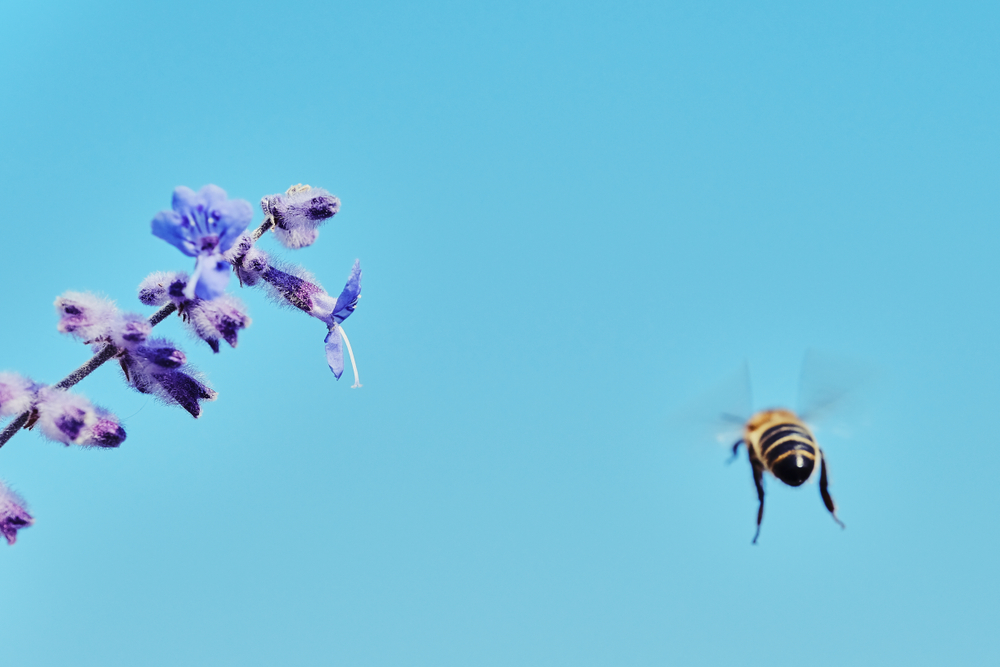Bees Can Fly Higher Than Mount Everest – Reaching Altitudes Over 29,000 Feet

Picture this: You’re standing at the base of Mount Everest, gazing up at its towering peak—29,032 feet above sea level. Up there, the air is so thin that most humans would struggle to breathe without an oxygen tank. Even helicopters have trouble flying that high. But against all odds, a tiny bumblebee can. Scientists once assumed that such extreme altitudes were beyond the physical limits of insects. After all, most aircraft need sophisticated engineering to navigate these conditions. And yet, nature—once again—proves us wrong.
Researchers have discovered that certain alpine bumblebees can not only survive at Everest-like heights but actually fly past them. In a controlled experiment, scientists simulated these brutal conditions and watched in amazement as bees adapted in real time, defying expectations with a simple but brilliant adjustment in their wing movements. But here’s the real mystery: How do these tiny creatures sustain their energy in an environment where oxygen is scarce? And what can we, as humans, learn from their ability to break through supposed “limits”?
The Experiment: Testing the Limits of Flight
 Image source: Shutterstock
Image source: Shutterstock
How high can a bumblebee go? To find out, researchers Michael Dillon and Robert Dudley conducted a fascinating experiment with alpine bumblebees from Sichuan, China—an area where these insects already thrive at over 10,000 feet above sea level. Instead of tracking them in the wild, the scientists recreated extreme altitude conditions in a controlled environment. Using a specially designed pressure chamber, they gradually reduced air pressure to mimic the thin atmosphere found at the planet’s highest elevations. If the bees had the same flight limitations as most other insects, they would have struggled as the air became thinner. But what happened next defied expectations.
The results were astonishing. Some bees continued to fly effortlessly at simulated altitudes of 29,527 feet—nearly 500 feet higher than Mount Everest. While humans rely on oxygen tanks and advanced gear to function at such heights, these tiny creatures showed no signs of distress. It was as if flight itself was hardwired into them, immune to the limitations we assumed air density would impose. Their wings should have needed more air resistance to generate lift, yet they carried on, seemingly unaffected by the brutal conditions. This discovery not only shattered long-held assumptions about insect flight but also raised an even bigger question: how exactly were they achieving this?
What physical adaptations allowed them to keep flying when logic suggested they should have stalled and fallen? The answer lay not in flying harder, but in flying smarter—through a surprising adjustment in their wing movements that changed everything we thought we knew about aerodynamics.
The Secret Behind Their Flight
At first, the researchers expected the bees to compensate for the thinner air by flapping their wings faster, much like how humans breathe harder when we’re struggling for oxygen. But when they analyzed high-speed footage of the bees in action, they found something even more fascinating—the bees weren’t flapping faster at all. Instead, they adjusted their wing strokes, extending their range of motion and increasing the angle at which they beat their wings. By doing so, they scooped up more air with each movement, maximizing the lift needed to stay airborne despite the extreme conditions. It was an incredibly efficient adaptation, proving that these bees didn’t need brute force to conquer high altitudes—they needed precision.
This discovery reveals something profound about nature’s design. While human engineers spend years fine-tuning aircraft wings to improve efficiency, these bees instinctively execute aerodynamic adjustments that allow them to defy the laws of flight at altitudes where helicopters struggle to operate. Their ability to change their wing motion rather than just speed up their flapping is a lesson in adaptability—one that applies not just to insects, but to all living beings. When faced with challenges, the solution isn’t always to push harder; sometimes, it’s about working smarter, adjusting our approach, and finding a new way to rise.
Even more astonishing is the fact that these bees were able to make these adjustments instantly, without hesitation or trial-and-error. Unlike human pilots, who require extensive training and calculations to navigate extreme conditions, these tiny creatures executed a perfectly adapted flight pattern as if it were second nature. It raises a deeper question: Is this a genetic adaptation honed over generations, or is there an innate intelligence in nature that allows organisms to respond to challenges with such precision? Either way, their remarkable skill offers a reminder that nature often holds the answers long before we even think to ask the questions. But while this breakthrough explained how the bees managed to fly so high, one major mystery remained: how did they keep their energy levels up in an environment with so little oxygen?
What We Can Learn: Breaking Limits in Our Own Lives
 Image source: Pexels
Image source: Pexels
If a tiny bumblebee can defy the odds and soar higher than Mount Everest, what does that say about the limits we impose on ourselves? We’re often told that certain things are impossible—that success requires more strength, more resources, or more perfect conditions. But these bees prove that adaptability, not sheer force, is what truly allows us to rise. They don’t try to flap harder when the air gets thin; they change their approach, moving with intelligence rather than resistance.
How often do we hit obstacles in life and assume we’ve reached our limit? When we face challenges—whether in our careers, relationships, or personal growth—we tend to believe that pushing harder is the only way forward. But maybe the key isn’t working harder—it’s working smarter. Like these bees, maybe we need to adjust our angle, expand our reach, and rethink the way we approach difficulty. The environment around us might change, but our ability to adapt is what truly defines how far we can go.
The high-flying bumblebee isn’t just an insect with an impressive skill—it’s a living metaphor for resilience. It reminds us that limits are often illusions, that nature finds a way where logic says it shouldn’t, and that when we stop seeing obstacles as barriers and start seeing them as opportunities for adaptation, we unlock potential we never knew existed. So the next time you feel like you’ve reached your peak, ask yourself: Is this really the highest I can go, or am I just flying with the wrong technique?
How Nature Redefines What’s Possible
 Image source: Shutterstock
Image source: Shutterstock
If bees can fly higher than Everest, what other limits have we assumed were unbreakable—only to be proven wrong by nature? The bar-headed goose soars over the Himalayas at nearly 30,000 feet, thriving in oxygen levels that would leave most creatures gasping. Tardigrades survive in space, enduring radiation and extreme conditions once thought incompatible with life.
Time and again, science has been forced to reconsider what’s possible. Breaking the sound barrier was once believed to be impossible. So was running a mile in under four minutes. Deep-sea creatures were assumed to be nonexistent beyond crushing ocean depths—until we found them thriving in the dark.
Nature constantly redefines limits, proving that barriers often exist only in our assumptions. If the natural world refuses to settle for the impossible, why should we?
Nature’s Blueprint for Success
The ability of a bumblebee to fly higher than Mount Everest is more than just a fascinating scientific discovery—it’s a testament to the sheer brilliance of nature. These tiny creatures don’t rely on force or struggle to overcome extreme conditions; they instinctively adapt. They don’t question whether it’s possible to fly at 29,000 feet, nor do they stop to consider the odds stacked against them. Instead, they adjust, they refine, and they keep going. In a world where survival often depends on brute strength, these bees prove that intelligence, efficiency, and adaptability are just as—if not more—powerful than raw effort.
For us, their flight holds a deeper message. We live in a society that often tells us to push harder, grind longer, and exhaust ourselves in the pursuit of success. But maybe real growth isn’t about working until we burn out; maybe it’s about learning how to navigate challenges in a way that makes the impossible achievable. When faced with adversity, we have a choice: we can either let the conditions define our limits, or we can change the way we move. The bees didn’t fight the thin air; they embraced it and learned to move differently.
The same applies to our own lives. Whether we’re facing personal struggles, career setbacks, or internal doubts, we must ask ourselves—are we truly at our limit, or are we just resisting the necessary change? The most successful people aren’t always the ones who work the hardest; they’re often the ones who adapt the fastest, who recognize when their old methods no longer serve them, and who are willing to approach obstacles from a new angle. Like the bumblebee, we are built to do more than we believe. The sky—no matter how high it seems—is never the limit. The only question is, will we rise to meet it?
Featured Image Source: Shutterstock
Loading...






